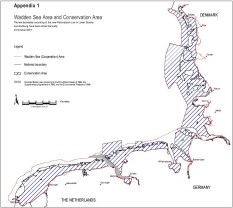|
You are here: /
The Approach / Arrangements
To facilitate ICZM,
we discern three types of arrangements which need attention. |
|
Institutional arrangements
These take care of the co-ordination of management practises
at the different levels (vertical integration) and sectors
(horizontal integration) of public institutions. These
institutes (ministries, research institutes, departments)
might already exist in which case linkages between them
must be created or strengthened. If they don't, they have
to be created. |
|
Horizontal vs. vertical
The direction of integration is time dependent: planning
may start with the co-ordination of plans of several ministries
and during evaluation involve vertical integration within
each ministry. The opposite happened in the USA, where
provisions for public involvement were extended throughout
the planning and implementation process. |
|
Roles and responsibilities
The role of institutions who take part in ICZM is threefold
(UNEP95):
- an executive role, for decision making;
- a judicial role, for enacting regulations and directives,
standards and procedure enforcement and arbitration;
- a marked role, allocating funds, offering incentives
or subsidies.
At each level, specific responsibilities can be discerned.
National administration should be concerned with
development and implementation of broad coastal management
policy, and designate a lead agency for coastal management
at the national level (e.g. a ministry). The policy should
be formulated in a basic plan which can be used to inform
lower authorities about the intentions of the national
government. Regional administration must, depending
on its authority, make more detailed but integrated planning.
They also have to co-ordinate the activities of local
authorities. Local administration has detailed
planning, development and implementation tasks. |
|
Legal arrangements
The jurisdiction over the coastal zone is very complex.
In many countries the sea bordering the land is under
jurisdiction of a regional government. The zone between
12 and 200 nautical miles may be - and often is - claimed
as an exclusive economical zone since the Convention on
the Law of the Sea in 1982 was enforced. The land bordering
the sea is under jurisdiction of the local government,
though the sea defence might be under jurisdiction of
an institute who is responsible for safety against flooding
(e.g., a water board). Further, some countries allow people
to have private ownership of the beach, and nature conservation
institutes might own large nature areas in the coastal
zone, either in the sea, the land or both.
This is the situation in which ICZM must operate. The
ICZM program must apply to the whole geographical area
which is involved in the issues at hand, irrespective
of legislative aspects. Thus, the area to which the
program will apply, will cross legislative boundaries
anyhow, even international ones, if necessary. To ICZM
program must therefore carefully be designed. It must
comply with the need to have legal authority to regulate
activities on the land and in the sea. In some cases
such an authority already exists; it need not be replaced,
but be incorporated in the ICZM process somewhere in
the future.
|
Example: a complicated area
 An
example of an ICZM program in an area crossing several
borders is the Waddensea project. The project contains
land and sea from three countries, and in each country
several provinces and many communities are affected. The
Trilateral Governmental Conferences which are held every
3 - 4 years, are the highest decision making body in the
framework of the collaboration. In the periods between
the Governmental Conferences, the Trilateral Working Group
(TWG), as a permanent working group meets, on average,
four 4-3 times a year. The TWG is composed of civil servants
of the responsible ministries and other relevant ministries
as well as regional authorities. An
example of an ICZM program in an area crossing several
borders is the Waddensea project. The project contains
land and sea from three countries, and in each country
several provinces and many communities are affected. The
Trilateral Governmental Conferences which are held every
3 - 4 years, are the highest decision making body in the
framework of the collaboration. In the periods between
the Governmental Conferences, the Trilateral Working Group
(TWG), as a permanent working group meets, on average,
four 4-3 times a year. The TWG is composed of civil servants
of the responsible ministries and other relevant ministries
as well as regional authorities.
|
Financial Arrangements
The amount of funding necessary will vary during the several
stages and vary according to the specific setting of a
region.
If necessary institutions exist, having staff from appropriate
disciplines and experience, and much information (for
the coastal profile) is already available, large sums
of funding are not required during the Initiation and
Planning stages. The mentioned staff could be delegated
to an ICZM office leaving a few selected positions open
for funding. The funding of these might be received from
the national government or from international agencies.
However, if people must be trained and / or hired,
or institutions have to be set up, the financial needs
rise. This particularly applies if during the implementation
stage large projects are started in the coastal zone.
Fortunately, since the Earth Summit in 1992, international
agencies and donors are increasingly willing to fund
ICZM related activities. One of the reasons is that
international agreements now state that any activity
in coastal zones on a national level should be carried
out within the framework of ICZM. Funds could be given
by the WorldBank, a regional development bank, the Global
Environment Facility and international aid agencies
in several countries.
Also the European Union provides funding for a ICZM
related projects. Have a look for more information.
|
|

|
|